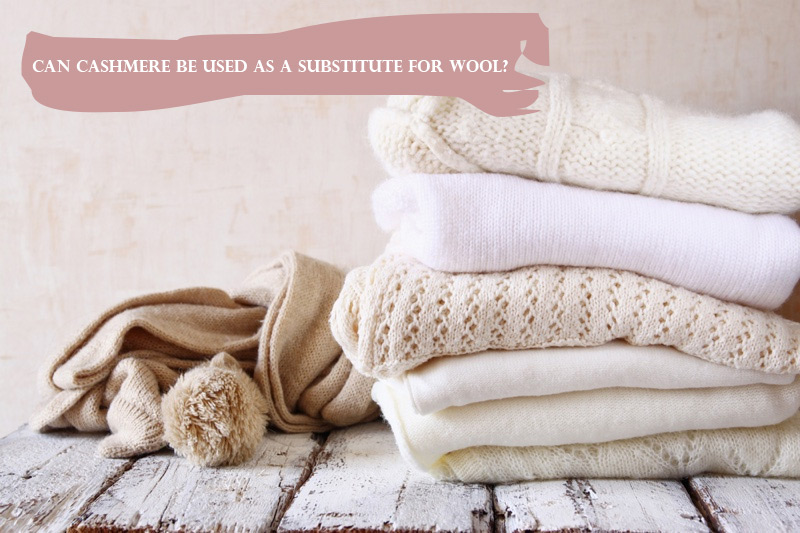
Cashmere and wool are two luxurious natural fibers that are widely used in the fashion industry for their warmth, softness, and durability. While they share some similarities, they have distinct differences that make them unique. As a result, many people wonder if cashmere can be used as a substitute for wool. In this blog post, we will explore the similarities and differences between cashmere and wool and determine if cashmere can be used as a substitute for wool.
Table of Contents
What Is Cashmere?
Cashmere is a fine, soft, and lightweight fiber that comes from the undercoat of the cashmere goat. These goats are primarily found in the regions of Inner Mongolia, Tibet, and Kashmir. Cashmere fibers are extremely fine and delicate, measuring around 14-19 microns in diameter. This makes them significantly thinner than most wool fibers, which typically range from 25-40 microns in diameter. Cashmere is known for its incredible softness, warmth, and insulation properties, which make it a highly sought-after luxury fiber.
What Is Wool?
Wool, on the other hand, is a natural fiber that comes from the fleece of sheep. It is a versatile material that has been used for thousands of years in clothing and textiles. Wool fibers are typically thicker than cashmere fibers, ranging from 25-40 microns in diameter. The thickness of wool fibers varies depending on the breed of sheep, and different types of wool have different characteristics. For example, merino wool is known for its softness and fineness, while Shetland wool is known for its durability and warmth.
Similarities Between Cashmere and Wool
Cashmere and wool share several similarities that make them popular materials in the fashion industry. First, they are both natural fibers, which means they are biodegradable and sustainable. They are also excellent insulators, making them ideal for cold weather garments. Additionally, both fibers have natural moisture-wicking properties, which helps to regulate body temperature and keep the wearer dry and comfortable.
Differences Between Cashmere and Wool
While cashmere and wool share some similarities, they have distinct differences that set them apart. Here are a few key differences to consider:
You may also like: Vacellis Clothing Reviews | Seatexcite.com Reviews | Acorpstyle Reviews | Benefits Of Women Wearing Tight Leggings While Working Out | What is the Current Trend For Women's Clothing? | About Finding A US Clothing Manufacturer? | Why Should You Check Reviews Before Buying Bras?
- Softness: Cashmere is widely regarded as one of the softest fibers in the world, with a luxurious feel that is unmatched by most other materials. Wool, on the other hand, can be soft but is often coarser and scratchier than cashmere.
- Warmth: Cashmere is known for its exceptional warmth and insulation properties. It is up to eight times warmer than wool, making it ideal for use in winter garments. Wool, while still warm, is not as insulating as cashmere.
- Durability: Wool is known for its durability and resilience, making it an excellent choice for outerwear and other garments that need to withstand wear and tear. Cashmere, on the other hand, is delicate and prone to pilling and damage.
- Price: Cashmere is significantly more expensive than wool, making it a luxury fiber that is often reserved for high-end fashion items. Wool is more affordable and accessible, making it a popular choice for everyday wear.
Can Cashmere Be Used as a Substitute for Wool?
Given the differences between cashmere and wool, it is clear that they cannot be used interchangeably in all situations. While cashmere is softer and warmer than wool, it is also more delicate and less durable. This means that cashmere is not suitable for garments that will be subjected to heavy wear or frequent washing. Wool, on the other hand, is an excellent choice for outerwear and other garments that need to withstand wear and tear.
That being said, cashmere can be used as a substitute for wool in certain situations. For example, cashmere sweaters and scarves are ideal for layering under a wool coat or jacket, providing extra warmth and insulation without adding bulk. Cashmere can also be used to add a touch of luxury to wool garments, such as cashmere-lined gloves or hats. In these cases, cashmere acts as a complementary material rather than a substitute for wool.
It is worth noting that the high price of cashmere means that it may not be a viable substitute for wool in all situations. For those on a budget, wool remains the more practical and accessible option for everyday wear. However, for those who prioritize luxury and quality, cashmere can be a worthwhile investment that adds an extra touch of softness and warmth to their wardrobe.
In conclusion, while cashmere and wool share some similarities, they have distinct differences that make them unique. While cashmere can be used as a complementary material to wool, it is not a practical substitute in all situations. When choosing between cashmere and wool, it is important to consider factors such as softness, warmth, durability, and price to determine which material is best suited for your needs.
Leave feedback about this